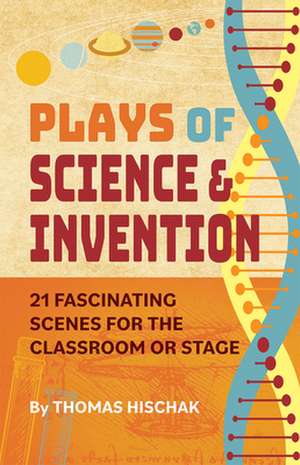Plays of Science and Discovery: 21 Fascinating Scenes for the Classroom or Stage
Autor Thomas Hischaken Limba Engleză Paperback – 23 mai 2021
Preț: 112.15 lei
Nou
Puncte Express: 168
Preț estimativ în valută:
21.46€ • 22.35$ • 18.14£
21.46€ • 22.35$ • 18.14£
Carte disponibilă
Livrare economică 17 februarie-03 martie
Preluare comenzi: 021 569.72.76
Specificații
ISBN-13: 9781566082662
ISBN-10: 1566082668
Pagini: 192
Dimensiuni: 140 x 216 x 11 mm
Greutate: 0.28 kg
Editura: Meriwether Publishing Ltd
Colecția Meriwether Publishing (US)
ISBN-10: 1566082668
Pagini: 192
Dimensiuni: 140 x 216 x 11 mm
Greutate: 0.28 kg
Editura: Meriwether Publishing Ltd
Colecția Meriwether Publishing (US)
Cuprins
Acknowledgements; Preface; 240 BC Footsteps Around the World (2M 1 boy): The Greek mathematician and astronomer Eratosthenes tries to convince the Egyptian pharaoh Ptolomy III that the plant Earth is not flat and describes how he has managed to measure its circumference; 1250 Miracle Glass (3W 1M): A Medieval glass craftsman, working on a panel of stained glass for the Siena Cathedral, discovers that objects are magnified when viewed through curved pieces of clear glass, a concept that would lead to the earliest form of eye glasses; 1519 Mirror Image Scribbling (2M): After the death of Leonardo da Vinci, his pupil Francesco Melzi defends his teachers anatomical drawings and mechanical sketches to a skeptical French aristocrat who sees Leonardo only as an artist; 1529 The Mad Prophet of Medicine (2W 2M 1 girl): The itinerant physician Paracelsus is scorned by the medical community because of his radical ideas about the source of disease coming from outside the body and not by unbalanced humours within; 1634 And Yet It Moves (2W 2M): The aged Galileo Galilei, put under house arrest by the Pope for his heretical ideas about the Earth revolving around the Sun, is visited by his two children who smuggle out some of their fathers manuscripts to be published abroad; 1795 To Frame My Face (2W 1M): An aristocratic French lady who survived the smallpox is scarred for life and finds a new identity as a cabaret singer disguised under stage makeup; 1833 Noise (2 M 2 W): Inspired by the the electromagnet system by Charles Thomas Jackson, the acclaimed painter Samuel Morse turns to science and invents a telegraph device with a sound code; 1876 Words and Wires (2W 2M): Inventor Alexander Graham Bell, who works with two deaf students, is studying the transmission of sound with assistant Thomas A. Watson and they stumble onto the basis for the telephone. ; 1896 No Wires (1W 3M): Young Italian inventor Guglielmo Marconi and his mother arrive in England to get funding for his new radio transmission system and get the British Admiralty interested in his wireless invention; 1901 The Train to Tuskegee (1W 2M): The African American agricultural scientist George Washington Carver, waiting for a train with a white farming couple, enlightens them on how to improve the productivity of their cotton farm; 1914 Little Curies (2W 2M): During World War One, Madame Curie and her daughter Irene struggle to get mobile X-ray machines to the front-line hospitals in France to aid surgeons in treating wounded soldiers; 1925 King of the Universe (2W 2M): The young British-American astronomer Cecilia Payne goes against conventional scientific thinking when she determines that the Sun is composed mostly of hydrogen, getting resistance from an older, renowned Princeton astronomer; 1928 Mold Juice (2W 2M) ; Doctor and scientist Alexander Fleming returns from vacation to his laboratory to find mold growing in one of his Petri dishes containing the staph culture, leading him to the discovery of penicillin; 1939 Garage Guys (1W 2M): Bill Hewlett and David Packard, electrical engineers who met while attending Stanford University, form the innovative electronics company Hewlett-Packard on New Years Day in Packards garage; 1942 The Movie Star and the Composer (1W 3M): Hollywood beauty Hedy Lamar and avant-garde composer George Antheil present an ingenious plant to confuse and disable enemy radio torpedoes but the U.S. Navy does not take the movie star and composer seriously and rejects their ideas; 1944 Decoding the Doll Woman (1W 2 M): Renowned cryptologist Elizebeth Smith Friedman helps the FBI close in on a spy who was using her antique doll shop in New York City as a means of passing on vital information about U.S. Navy ships to the Japanese; 1951 Feeding the Enemy (1W 1M): The African American biochemist Jane C. Wright explains to her father, director of the Harlem Hospital Research Center, that she may have found a way to make chemotherapy effective in destroying cancer cells; 1962 No More Bird Song (3W 1M): Nature author and environmentalist Rachel Carson, in the hospital and being treated for cancer, sees the publication of her book Silent Spring threatened by big chemical companies who try to keep the truth about harmful pesticides from reaching the public; 1980 Magic Rings (2W 1M): A retired science teacher, who has studied the planet Saturn all his life, is in a nursing home but lives long enough to see the first up-close photos of the planet taken by the space probe Voyager 1; 1999 The Millennium Bug (2W 1M): As midnight approaches on New Years Eve and the new century begins, two astronomy professors and a student are in the college planetarium to see what affect the Y2K factor has on the computer which operates the star presentation; 2021/351 BC. Modern Medical Advice (2W 2M): The Greek physician Hippocrates examines a middle-aged female patient in his medical school while a 21st-century doctor examines her middle-aged male patient, both with similar ailments, and both doctors using Hippocrates timeless approach to medical practice; Appendix of Plays by Topics; About the Author; Performance Application.
